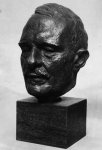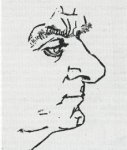Boethius [Anicius Manlius Severinus Boethius]
(b Rome, c480 CE; d Pavia, c524 CE). Roman writer and statesman. He was born into one of the foremost patrician families of Rome; following the death of his father in 487 CE he was taken into the home of Symmachus, another patrician. Boethius learnt Greek philosophy and the liberal arts from Symmachus and married his daughter. Both men were colleagues in later senatorial struggles.
Boethius’s erudition in both the practical and speculative arts attracted the attention of Theodoric the Ostrogoth, then ruler of Italy. Through Cassiodorus, Theodoric requested Boethius’s aid in various matters, including the selection of a kitharode for Clovis, King of the Franks. Cassiodorus, writing in his official capacity as quaestor, repeatedly praised Boethius’s learning. Boethius became consul in 510, and in 522 was called to Ravenna to become Theodoric’s magister officium. In 523 Cyprian, Theodoric’s referendary, brought charges of treason against a senator, Albinus, and Boethius argued in Albinus’s defence. Boethius was himself then charged and imprisoned with Albinus in Pavia, and ultimately executed.
The works of Boethius may be divided into four categories, in chronological order: didactic works, treatises on the mathematical disciplines probably written during the first decade of the 6th century; the logical works, in essence translations or commentaries on Aristotle, Cicero and Porphyry; the theological treatises, works expounding orthodox Christian doctrine according to philosophical methods; and the Consolatio philosophiae, a philosophical treatise written in the form of a Menippean Satire while Boethius was in prison.
Boethius’s first works, written at the request of Symmachus, and dedicated to him, treated the four mathematical disciplines of antiquity: arithmetic, music, geometry and astronomy. Boethius described these disciplines as the ‘quadrivium’, the fourfold path to the knowledge of ‘essences’ – things unaffected by material substance (De inst. arith., preface). Of the four works covering these disciplines, only the De institutione arithmetica and the greater part of the De institutione musica survive, although contemporary sources and later evidence show that Boethius probably completed all four works.
Unlike most of his contemporaries, Boethius did not merely repeat classical learning for rhetorical and encyclopedic purposes: he was a speculative thinker in the Greek philosophical tradition. Thus his mathematical works are not merely introductions to the fields of study with which the learned Roman should be acquainted; they are highly developed preparatory exercises for the study of philosophy in the neo-Pythagorean and neo-Platonic tradition. The work on arithmetic is a translation of Nicomachus of Gerasa’s Introduction to Arithmetic; the treatise on geometry was a translation of Euclid’s Elements; and the De astronomia followed Ptolemy’s Almagest. Evidence in the extant musical treatise by Nicomachus (Manual of Harmonics) and in Boethius’s treatise itself suggests that the first four books of De institutione musica are a somewhat loose translation of Nicomachus’s lost work on music. The fifth book of De institutione musica, however, is based on the first book of Ptolemy’s Harmonics. Boethius’s treatise is incomplete, for it breaks off in the middle of book 5, and the last part of the work – probably comprising two further books (based on Ptolemy) after the lost final chapters of book 5 – seems to have disappeared not long after the work was written.
Music occupies an unusual position among the mathematical arts, according to Boethius, for it is related to ethical action as well as to pure reason (De inst. mus., 1, chap.1). Since human behaviour is potentially influenced by music, it is very desirable to understand and control the fundamental elements of music (e.g. tonal systems, genera, modes). Moreover, music, in the form of musica mundana, is an all-pervading force in the universe – determining the courses of the stars and planets, the seasons of the year and the combinations of the elements; and as musica humana it is the unifying principle for the human being – bringing the body and soul into harmony, and integrating the rational and irrational parts of the soul and the disparate members of the body into harmonious wholes. Music is also said to be found in instruments (musica instrumentalis), which are subdivided into strings, winds, and percussion (De inst. mus., 1, chap.2).
Boethius defines the true musician (musicus) as the scholar who can judge poetic compositions and instrumental performances by the application of pure knowledge; this scholar is to be distinguished from the poet, who composes songs more by instinct than by knowledge, and the instrumentalist, who is little more than a skilled craftsman (De inst. mus., 1, chap.34).
The ultimate goal of the study of music for Boethius was fixed and unchanging knowledge. If music is to be known, it must be quantified; the transient sounds perceived by the senses, quantitative in their very nature, must be translated into ratios that correspond to discrete musical intervals. Thus a system of numerical ratios (two terms) and proportions (three or more terms) is constructed, and the structure of musical systems (collections of pitches) is determined by those ratios considered the simplest and closest to unity (multiple and superparticular ratios). Musical intervals are considered consonant or dissonant according to the integrity and simplicity of their mathematical ratios. Only after the full exposition of an elaborate and sometimes tedious musical mathematics are the basic elements of music translated back into audible sound by means of the monochord, the instrument with which one can make audible the mathematical ratios as well as the genera and systems tempered by pure mathematics.
Several passages in Boethius’s De institutione musica are of particular import in the history of musical thought. A clear and perceptive theory of sound is found in book 1, chap.14. The final chapter of book 4 presents a distinction between interval (a relationship between successive sounds) and consonance (one between simultaneous sounds). Book 4, in chaps.14–17, discusses the basic elements of Greek modal theory with notational charts clearly illustrating the basic principles of that system.
The De institutione musica fell into virtual oblivion between the 6th century and the 9th, but emerged as an important work in the revival of the liberal arts during the Carolingian renaissance. Evidence in the manuscript tradition of Cassiodorus’s Institutiones places Boethius’s musical work in the court library of Charlemagne: two early 9th-century codices (D-KA CVI and CH-BEsu 212) preserve one of the earliest traditions (known as the Δ recension) of the second book of Cassiodorus’s Institutiones – that which discusses the seven liberal arts. Bischoff has argued that these codices as a whole preserve a textual tradition stemming from the court of Charlemagne. The same codices also contain a short treatise entitled Quantis cordis antiqui musici ubi sunt quorum Boethius in capitulo, de additione vocum, meminit quaeve sunt eorum nomina vel ordo (‘On how many strings were used by the ancient musicians, on which Boethius, in his chapter “On the addition of pitches”, recalls what they are, their names and their arrangement’). The title itself and the names of notes and genera recorded in this very brief treatise testify to a knowledge of Boethius’s work among Frankish scholars and scribes from the earliest decades of the 9th century.
The manuscript tradition of De institutione musica, preserved in over 150 codices containing the work or extracts from the work, represents the most extensive textual tradition of any musical treastise of the Middle Ages. The reception of the De institutione musica from the 9th to the 12th centuries can be traced in an extensive commentary, known as the Glossa maior, found in the margins of numerous manuscripts containing the work. The earliest layer of commentary, dating from the middle third of the 9th century, concentrates on philosophical, philological and mathematical aspects, and ignores any relationship between musica, the mathematical discipline, and cantus, the musical practice of the period. The philosophical commentary of these decades exhibits strong parallels with the Platonic thought of contemporary thinkers, particularly Johannes Scottus Eriugena (d c877). Only in the final third of the 9th century does the commentary begin to acknowledge a contemporary musical practice and cite specific examples from the plainchant repertory.
The epistemological emphasis of Boethius became a predominant theme in medieval music theory from its earliest flowering in the late 9th century. Extensive elements and literal quotes from De institutione musica are found in the Musica enchiriadis and in the treatises of Aurelian of Réôme, Regino of Prüm and Hucbald. During the 10th and 11th centuries the Pythagorean diatonic musical system espoused by Boethius formed the essential collection of pitches imposed on the repertory of liturgical chant and subsequently became the basis of musical notation – with relatively little concern for the many incongruities that existed between the chant melodies and Boethius’s highly restricted set of pitches. The distinction between the musicus and cantor, a dichotomy that clearly exercised a negative influence in the application of systematic musical thought to the innate nature of the repertory of chant, is ultimately rooted in Boethius’s philosophical position. Not until Guido of Arezzo (d after 1033) was Boethius candidly regrouped with philosophers rather than musical theorists; yet even Guido repeated the myth of Pythagoras and the smithy – a myth that espouses the essentially Pythagorean basis of musical thought. Although Boethius’s influence waned in the later Middle Ages as theory became more oriented toward musical practice, his work nevertheless remained an auctoritas of ultimate appeal in musical thought throughout the later Middle Ages and even well into the early 17th century.
Bibliography
Editions, translations
G. Friedlein, ed.: Anicii Manlii Torquati Severini Boetii De institutione arithmetica libri duo. De institutione musica libri quinque. Accedit Geometria quae fertur Boetii (Leipzig, 1867/R)
C.M. Bower, trans.: Fundaments of Music (New Haven, 1989) [incl. introd. and notes]; review by L. Gushee, JMTh, xxxviii (1994), 328–43
M. Bernhard and C.M. Bower, eds.: Glossa maior in institutionem musicam Boethii (Munich, 1993–6)
G. Marzi, ed.: An.M.T. Severini Boethii de institutione musica (Rome, 1990)
Studies
H. Abert: Die Musikanschauung des Mittelalters und ihre Grundlagen (Halle, 1905)
R. Bragard: ‘L’harmonie des sphères selon Boèce’, Speculum, iv (1929), 206–13
G.W. Pietzsch: Studien zur Geschichte der Musiktheorie im Mittelalter: die Klassifikation der Musik von Boetius bis Ugolino von Orvieto (Halle, 1929/R)
G.W. Pietzsch: Die Musik im Erziehungs- und Bildungsideal des ausgehenden Altertums und frühen Mittelalters (Halle, 1932/R)
L. Schrade: ‘Die Stellung der Musik in der Philosophie des Boethius als Grundlage der ontologischen Musikerziehung’, Archiv für Geschichte der Philosophie, xli (1932), 368–400
O.J. Gombosi: Die Tonarten und Stimmungen der antiken Musik (Copenhagen, 1939/R)
M.F. Bukofzer: ‘Speculative Thinking in Medieval Music’, Speculum, xvii (1942), 165–80
R. Bragard: ‘Boethiana: études sur le “De institutione musica” de Boèce’, Hommage à Charles van den Borren: mélanges (Antwerp, 1945), 84–139
L. Schrade: ‘Music in the Philosophy of Boethius’, MQ, xxxiii (1947), 188–200
J.M. Barbour: Tuning and Temperament: a Historical Survey (East Lansing, MI, 1951/R, 2/1953)
H. Potiron: La notation grecque et Boèce (Rome, 1951)
H. Potiron: Boèce: théoricien de la musique grecque (Paris, 1954)
N.C. Carpenter: Music in the Medieval and Renaissance Universities (Norman, OK, 1958)
K.G. Fellerer: ‘Die Musica in den Artes liberales’, Artes liberales: von der antiken Bildung zur Wissenschaft des Mittelalters, ed. J. Koch (Leiden, 1959), 33–49
E.J. Dehnert: ‘Music as a Liberal Art in Augustine and Boethius’, Arts libéraux et philosphie au Moyen Age: Montreal 1967, ed. J. Vrin (Paris, 1969), 987–91
D.S. Chamberlain: ‘Philosophy of Music in the Consolatio of Boethius’, Speculum, xlv (1970), 80–97
J. Edmiston: ‘Boethius on Pythagorean Music’, MR, xxxv (1974), 179–84
C.M. Bower: ‘Boethius and Nicomachus: an Essay concerning the Sources of De institutione musica’, Vivarium, xvi (1976), 1–45
A. Barbera: ‘Arithmetic and Geometric Divisions of the Tetrachord’, JMT, xxi (1977), 294–323
C. Page: ‘The Earliest English Keyboard: New Evidence from Boethius’ De Musica’, EMc, vii (1979), 308–14
C.M. Bower: ‘The Role of the De Institutione Musica in the Speculative Tradition of Western Musical Thought’, Boethius and the Liberal Arts: a Collection of Essays, ed. M. Masi (Las Vegas, 1981), 157–74
J. Caldwell: ‘The “De Institutione Arithmetica” and the ‘De Institutione Musica”’, Boethius: his Life, Thought and Influence, ed. M. Gibson (Oxford, 1981), 135–54
H. Chadwick: Boethius: the Consolations of Music, Logic, Theology, and Philosophy (Oxford, 1981)
C.M. Bower: ‘The Modes of Boethius’, JM, iii (1984), 252–63
C.M. Bower: ‘Boethius' De institutione musica: a Handlist of Manuscripts’, Scriptorium, xlii (1988), 205–51
L. Vikárius: ‘A Boethius-Fragment: New Sources for Research into the Theoretical Musical Teaching in Medieval Hungary’, Cantus Planus III: Tihány 1988, 245–56
M. Bernhard: ‘Glosses on Boethius' “De institutione musica”’, Music Theory and its Sources, ed. A. Barbera (Notre Dame, IN, 1990), 136–49
M. Bernhard: ‘Überlieferung und Fortleben der antiken lateinischen Musiktheorie im Mittelalter’, Geschichte der Musiktheorie, iii: Rezeption des antikens Fachs im Mittelalter, ed. F. Zaminer (Darmstadt, 1990), 1–35
M. Bernhard: ‘Die musikalische Fachschrifttum im Lateinischen Mittelalter’, ibid., 37–103
A.C. and W.R. Bowen: ‘The Translator as Interpreter: Euclid's Sectio canonis and Ptolemy's Harmonica in the Latin Tradition’, Musical Discourse from Classical to Early Modern Times: Editing and Translating Texts: Toronto 1990, ed. M.R. Maniates (Toronto, 1997), 97–148
C.V. Palisca: ‘Boethius in the Renaissance’, Music Theory and its Sources, ed. A. Barbera (Notre Dame, IN, 1990), 259–80
J. Bofill i Soliguer: La Problemàtica del tractat De institutione musica de Boeci (Barcelona, 1993)
C.M. Bower: ‘Die Wechselwirkung von philosophia, mathematica und musica in der karolingischen Rezeption der “Institutio musicae” von Boethius’, Musik und die Geschichte der Philosophie und Naturwissenschaften im Mittelalter: Fragen zur Wechselwirkung von “musica” und “philosophia” im Mittelalter, ed. F. Hentschel (Leiden, 1998), 163–83
M. Hochadel: ‘Zur Rezeption der “Institutio musicae” von Boethius an der spätmittelalterlichen Universität’, ibid., 187–201
Calvin Bower
Grove










